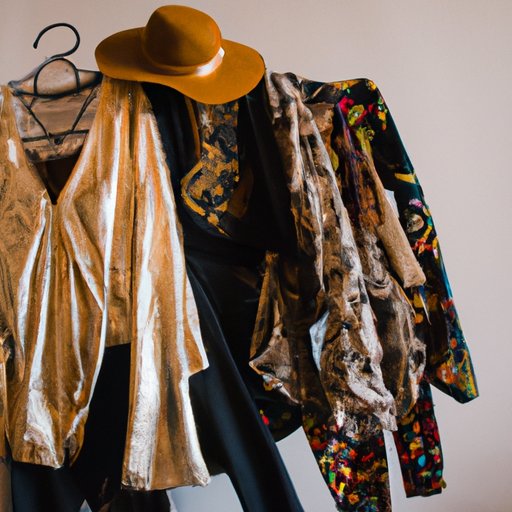Introduction
Fashion has always been an integral part of our lives and a way for us to express our individuality. However, in the age of consumer culture, fashion has taken on an entirely new meaning. Consumers have become obsessed with trends and buying the latest “it” items, but this obsession has led to the rise of fast fashion and a disregard for sustainability and ethical practices.
In this article, we will explore how people are rejecting fast fashion and embracing unique styles, the rise of sustainable and ethical fashion, thrifting and vintage clothing as a form of self-expression, technology changing fashion trends, supporting local fashion designers, and luxury fashion versus affordable fashion.

Defining Personal Style in Defiance of Fast Fashion
Fast fashion is the term used to describe the mass production of low-cost clothing that is designed to be worn only a few times before being discarded. As more and more consumers seek out the latest trends, stores like H&M, Zara, and Forever 21 have seen a surge in sales. Unfortunately, these stores often rely on unethical labor practices and produce clothing made from cheap, synthetic materials that don’t last long.
In response to this, many people are choosing to reject fast fashion and embrace unique styles that reflect their individual tastes. By shopping secondhand or investing in quality pieces from ethical brands, consumers can make sure their money is going towards something that will last and won’t contribute to the waste created by the fashion industry.
The Rise of Sustainable and Ethical Fashion
As more and more people become aware of the environmental and social impacts of the fashion industry, there has been a shift towards sustainable and ethical fashion. Sustainable fashion is defined as clothing that is produced using environmentally friendly methods and materials, while ethical fashion focuses on ensuring fair wages and working conditions for workers in the garment industry.
Many designers and retailers are now making an effort to reduce their impact on the environment and support ethical labor practices. There are also a growing number of independent brands that specialize in sustainable and ethical fashion, making it easier for consumers to find options that align with their values.
Thrifting and Vintage Clothing as a Form of Self-Expression
Another popular trend among fashion-conscious consumers is thrifting and vintage clothing. Thrifting refers to the practice of buying secondhand clothing from thrift stores, flea markets, or online platforms like eBay and Depop. Vintage clothing, on the other hand, is clothing that was made at least 20 years ago and is usually considered to be of higher quality than modern clothing.
The popularity of thrifting and vintage clothing can be attributed to its affordability and one-of-a-kind nature. By shopping secondhand, consumers can find unique pieces that reflect their personal style without breaking the bank. Plus, they can feel good knowing that their money is going towards supporting local businesses and reducing waste.
Technology Changing Fashion Trends
Technology has had a huge impact on the fashion industry, from the way clothes are made to the way they are marketed and sold. Social media has changed the way people discover and follow fashion trends, and many influencers have become the face of certain brands or styles.
Online shopping has also had a major impact, with many retailers now offering e-commerce platforms and same-day delivery services. This has made it much easier for consumers to find and purchase the latest trends, and has drastically increased the speed at which trends come and go.
Supporting Local Fashion Designers
In addition to shopping secondhand, another way to support the fashion industry is to shop locally. Supporting local fashion designers not only helps keep jobs within the community, but it also allows shoppers to find unique, one-of-a-kind pieces that they won’t find anywhere else.
By shopping locally, shoppers can get to know the designer and learn about their process and materials. Plus, they can ensure that their money is going towards supporting a business that is committed to ethical labor practices and sustainability.

Luxury Fashion vs. Affordable Fashion
Finally, there is the debate between luxury fashion and affordable fashion. Luxury fashion typically refers to high-end designer labels like Gucci and Prada, while affordable fashion includes brands like Zara and H&M. While luxury fashion often comes with a hefty price tag, it is usually of higher quality and lasts longer than affordable fashion.
That said, there are still plenty of affordable options out there that don’t sacrifice quality. By doing some research and reading reviews, shoppers can find pieces that are both stylish and durable.
Conclusion
In conclusion, the fashion industry has been greatly impacted by consumer culture. People are rejecting fast fashion and embracing unique styles, turning to thrifting and vintage clothing as a form of self-expression, and supporting local fashion designers. Technology has also changed the way fashion trends are discovered and purchased, and there is a growing debate between luxury fashion and affordable fashion.
At the end of the day, it’s important to remember that fashion should be a reflection of your personal style and not just a way to keep up with trends. As the saying goes, you can’t buy love – but you can invest in quality pieces that will stand the test of time.
(Note: Is this article not meeting your expectations? Do you have knowledge or insights to share? Unlock new opportunities and expand your reach by joining our authors team. Click Registration to join us and share your expertise with our readers.)
